Winter Audio Reference: On-Board, Consumer, and Pro Solutions
by Derek Wilson on February 3, 2005 12:05 AM EST- Posted in
- Smartphones
- Mobile
The Cards
These are the first cards that we'll be taking a look at in their categories. Other sound hardware reviews that we do will have a point of reference to this article. For onboard solutions, we'll compare against the Realtek HD audio that we're reviewing today. When we look at consumer level add-in cards, the obvious metric is the Sound Blaster Audigy 2. For professional cards, we've chosen the Echo Audio Gina3g as our point of reference for its mix of features and solid quality.
The Intel, Gina3G, and Creative mix touches on high quality, integrated, multitrack/music recording, gaming, and the consumer audio solutions. We wanted to hit all these groups in this review in order to get a feel for what each had to offer. The first solution that we'll look at is the Intel solution.
Realtek Intel HD Audio
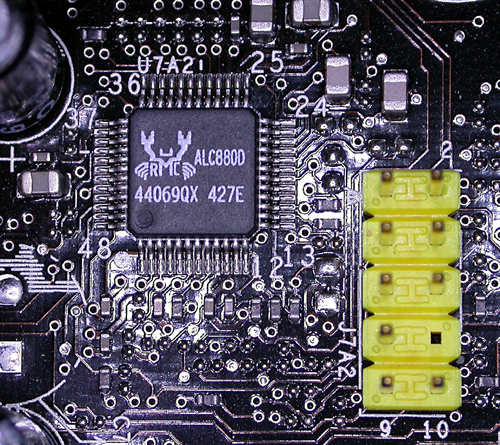
This is the Realtek Intel HD Audio codec chip.
As we can see, the Intel solution is the Realtek solution. We wanted to track down the DACs and opamps that drive the output, but finding these tiny chips on a motherboard proved too difficult a task for us. Suffice it to say that layout is key when dealing with an onboard solution. We actually plugged our Audigy in a PCI port further away from the video card, thinking we'd get better signal quality and noticed an 8dB increase in noise due to this:
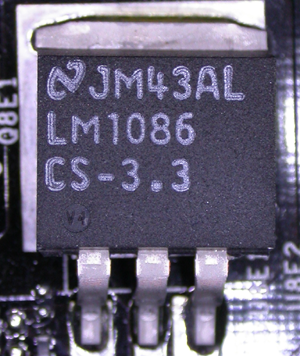
This is a 1.5A low dropout positive regulator near the 3rd PCI slot on the 925XE board.
Imagine the difficulty in guarding against noise with an onboard solution if simply moving to a different PCI slot can change so much. Vendors other than Realtek are planning on coming out with HD audio compatible onboard solutions, and we are looking forward to testing those as well.
On the downside, the Realtek only has 20 bit stereo inputs, so doing a 24bit loopback is a little less than honest. The record quality of this onboard solution is less than optimal, and in very loud playback, a little noise can be heard.
Echo Audio Gina3G
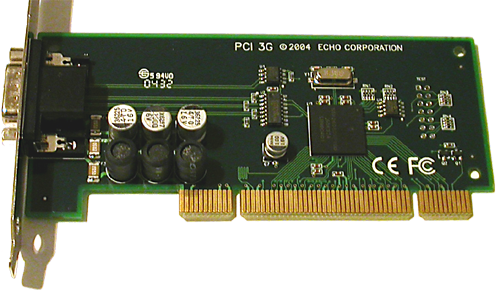
The Gina3G PCI card
The Gina3g is an entry level professional sound card from Echo Audio. Musicians on a budget are always on the lookout for a device that combines a few high quality analog inputs with a couple of coax and optical digital connections that support S/PDIF and ADAT I/O.
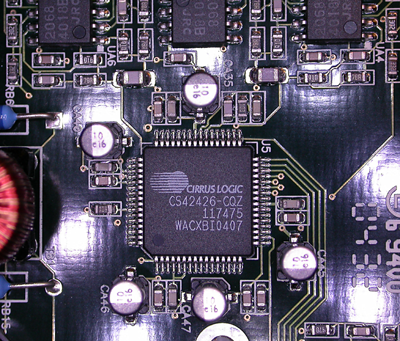
Inside the Gina3G breakout Box
This device would be a stop off on the way to something like the Lynx TwoB, or a DigiDesign ProTools solution. With the ability to record 8 digital channels at a time, 6 (highly configurable, balanced) analog outputs, and 2 universal analog inputs (accepts ¼ inch and XLR, balanced or unbalanced, and can provide 48v of phantom power), the Gina3g is targeted squarely at the end user looking to take their audio and put it on the PC. A small home studio could go the way of having a couple of rack mount devices - compressors, eqs, and an A/D - to bundle it all up and send it to the PC. The Gina would fit in nicely. There are both cheaper and more expensive solutions out there.
In any case, the reason why we are testing the Gina3g today is because its older siblings have done very well traditionally in terms of analog signal quality. We wanted to find out if Echo Audio's latest in the series still stacks up.
Creative SoundBlaster Audigy 2 ZS Platinum Pro
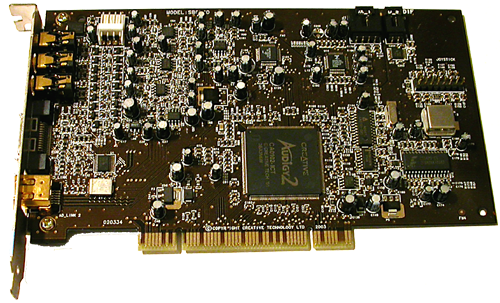
SoundBlaster Audigy 2 ZS Platinum Pro PCI Card
The Audigy is the consumer standard in sound hardware today. It is a very gamer and entertainment PC oriented solution. The Platinum Pro is a Swiss army knife of a sound card - a little of everything, but never exactly what you want. Digital playback is quality, but analog at 16-bit/44.1 kHz leaves something to be desired. Recording quality is solid, but there could be more I/O on the device if it is going to fit into any aggressive user's workflow. Lacking balanced analog I/O is a large oversight if Creative wanted to target the prosumer/audiophile. But in the end, the audigy does fit into just about every niche in which you could want a sound card. And it offers EAX Advanced HD as only Creative cards can.
Creative SoundBlaster Audigy 4 Pro
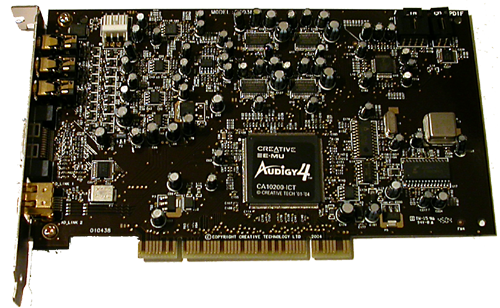
SoundBlaster Audigy 4 Pro
The SoundBlaster Audigy 4 Pro is basically an upgraded and massaged version of the Audigy 2 ZS Platinum Pro. The differences are in the quality of the DACs and ADCs used, some layout changes, and just a bit of a polish that makes the quality of the card fit the feature set better. Still offering the same gaming quality, the analog output of the card is now on par with professional level cards in some respects.
Summarizing the Differences
So, what are the key factors that are different among the contenders? Let's take a look:
-- DAC quality: the Audigy 4 has the highest quality DACs, though the Gina3G places it's DACs outside the PC in its breakout box. Here are the DACs used on the Audigy and Gina3G:
Audigy 2 DAC: 1x CS4382: 8out 114dB dynamic range, -100dB THD+N
Audigy 4 DAC: 4x CS4398: 2out 120dB dynamic range, -107dB THD+N
Gina3G DAC: 1x CS42426: 2in/6out 114dB dynamic range, -100dB THD+N
Both Audigy products use 4558c opamps with THD < .008%
Gina3G uses NJM2068 opamps with THD < .001%
-- Input quality: The Gina3G uses balanced I/O, and has the most input options. The quality of the ADCs on the Gina3G and Audigy are similar (Audigy is noisier with less THD). The Intel Audio solution only supports recording at a max of 20-bit/96kHz analog, and is noisy on recording. No pro digital recording features are enabled on the onboard solution even when lightpipe is present, so Creative and Echo have the Intel beat in digital recording as well.
-- Gaming features: The Creative solutions offer EAX 4.0 Advanced HD, which neither of the other cards can claim. Intel is able to include EAX 2.0 support along side it's DS3D and A3D support, but the Gina3G offers zero 3D hardware support or reverb API support. Included on the Gina3G is a DSP that is capable of such operations (Xilinx Spartan), but it's obviously intended for professional applications.
Other than that, the differences are in feature set and drivers. The Audigy cards offer the most in terms of "stuff" with their cards, though the Intel solution does a good job of filling in the gaps as well. Even though the Gina3G "only" supports 6-channel out on the consumer side, the fact that all 6 outputs are balanced TRS ¼ inch is a nice bonus for the musician. Depending on implementation, the Realtek solution can have optical and coax output, but Audigy and Gina3G both offer optical and coax in and out.










89 Comments
View All Comments
EddNog - Thursday, February 3, 2005 - link
ProviaFan, take a look at the Paradigm stuff, or if you've got decent multichannel power, I also feel that Magnepan's smaller speakers give good sound for the money (MMGs for example). I'm not sure if a Magnepan setup is in your budget (definitely worth the money if you can afford it, though, and comparably cheaper than many other audiophile HT solutions), but Paradigm's midrange (i.e. not Reference series) stuff should be pretty affordable. It's probably no cheaper than Magnepan to outfit your HT with Paradigm Reference, though.Of course there's plenty of other options out there. On the more affordable end, perhaps try some Cambridge Newton Series sats/bookshelves in conjunction with a Velodyne sub.
-Ed
Jigga - Thursday, February 3, 2005 - link
#26 is right on the mark--need ALC850 and Envy24 reviews STAT!ProviaFan - Thursday, February 3, 2005 - link
Response to the audiophile that just posted: Yes, good cable is important, but good cable can be made at home for not terribly large amounts of money... Anything that costs hundreds of dollars per foot is not necessarily bad, but is nonetheless a terrible waste of money, because _there is no difference_. If you hear a difference between a $4 cable and a $40 cable, there probably is a difference. If you hear a difference between a $40 cable and a $4000 cable, it's in your head.With that said, I'd like to know of what to look for in a _good_ 5.1 monitor speaker setup (not consumer gaming quality, but not break-the-bank "audiophile" monitors based advertised with endless pseudoscience), as I might be in the market for something like that. :)
Oh, and if Derek has any extra spare time (yeah, sure ;), I would be interested to see where something like the M-Audio Delta 1010LT sits between the consumer cards and the other pro cards that he mentioned in one of his latest posts (MOTU, Digidesign, etc.).
vaystrem - Thursday, February 3, 2005 - link
Other than Ed I think I'm the only audiophile to post on this and this is my comment regarding your multichannel setup.You used professional monitors for the 2 channel listening, fine Sony isn't great but its ok.
And you used a consumer level speakers, Logitech, for your multichannel experience.
You could hear differences on 2 channel... but not multi channel. What has changed most significantly is... your speakers. As you state, speakers are what introduce the highest levels of distortion.
You can believe me, or not, but on my setup I can hear differences between CD players (Arcam 73t, Cary 308, Creek CD50, Roksan Kandy mkIII, Rega Planet 2000, Cambridge Audio Azur 640c for the curious), cabling and amplifiers.
You need to have better quality speakers for evaulating multichannel. I'm not arguing the speakers are even the most important component, I'm a source first kind of person. But I think that having better evaluatory tools would be helpful.
You absolutely have the right idea of having a 'reference'. Do not change it often. This is something Anandtech has always been good at with your other reviews. You use the same hardware/software tests over a longer period of time than other sites to ensure 'long term comparability'.
Including a subjective element to the tests would be interesting. Some sites to look at.
www.audioasylum.com Post a request on recommended testing methodologies and it might be helpful.
www.uhfmag.com (comparative reviews panel of listeners generally non blind)
www.hifichoice.co.uk (active use of blind listening panels here)
www.stereophile.com www.sixmoons.com
www.soundstage.com (does lots of measurements good comparisons)
Those might be useful.
Also, using some high quality headphones, Sennheiser, Beyerdynamic, Grado might be useful as well.
CSMR - Thursday, February 3, 2005 - link
There is a general ignorance the basics of what audio systems are composed of. A receiver has a completely different purpose to a PC audio card (Griffin powerwave excluded). You need three things: an analog line-level signal (from a DAC), amplification, and speakers. (Exception: digitally-controlled class D amplification.) A $200 receiver will not have as good dacs as those in for instance the EMU 1212m. A receiver is often a DAC and an amplifier. Sound cards generally do not contain amplification.dev0lution - Thursday, February 3, 2005 - link
I second that. While it's nice to know how the audio solutions stack up in testing, some real world advice & comparisons would be a lot more helpful. For example, using the Intel/Realtek onboard solution with quality optical cables straight to a Dolby Digital receiver with home theater speakers versus using an Audigy card to a set of mid-high end 5.1 computer speakers.Zak - Thursday, February 3, 2005 - link
I use SPDIF outputs to hook up my computers to external equipment, a receiver and set of "real" speakers. IMHO a $200 receiver sounds superior to any PC audio card. I get real DolbyDigital and DTS decoding, low CPU overhead. Maybe I miss some of the audio effects in games but I always thought that Creative EAX is way overhyped anyway and most of the time I'd have it turned off because the sound was just plain weird. I think as more games have support for Dolby 5.1 and better EAX will become less relevant.Zak
CSMR - Thursday, February 3, 2005 - link
The review's title should be: audio for gaming. Apart from gaming you have very many audio cards: E-MU, Ego Systems, Edirol, RME, M-Audio, etc.. For audio playback and recording these are the cards to consider; for gaming the reviewed cards are the ones to consider. (Not that they are bad: the Audigy 4 Pro is a good audio card, but around the level of the emu 0404, which costs less.)Slaimus - Thursday, February 3, 2005 - link
Including older cards is a great idea as many people are looking for an upgrade. Something I would like to see included personally:- classic SoundBlaster Live using the kX driver and swapped outputs.
- DFI's Karajan audio module with ALC850 compared to the standard implementation
- SoundBlaster Live 24-bit with the Wolfson DAC
DerekWilson - Thursday, February 3, 2005 - link
#37, bbomb, Good suggestion ...Title changed :-)
I'll add an updated to the conclusion as well that ties together what we were trying to do with the article and explains the point a little better ... I do applogize for the confusion on all this.
For the future, here are some chipsets and cards we want to include in the future:
envy24 boards (maudio and terratec)
realtek alc850 onboard
analog devices onboard
nvidia nf2 soundstorm
pro:
lynx (l22)
emu
digidesign (mbox or digi 002 rack + protools)
motu
rme
It does look like there's a lot of demand for older Turtle Beach and Creative cards, so we'll try to take a look at those as well for reference.